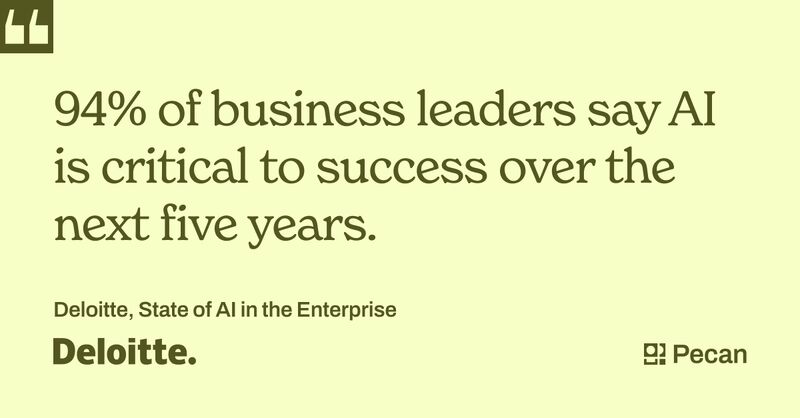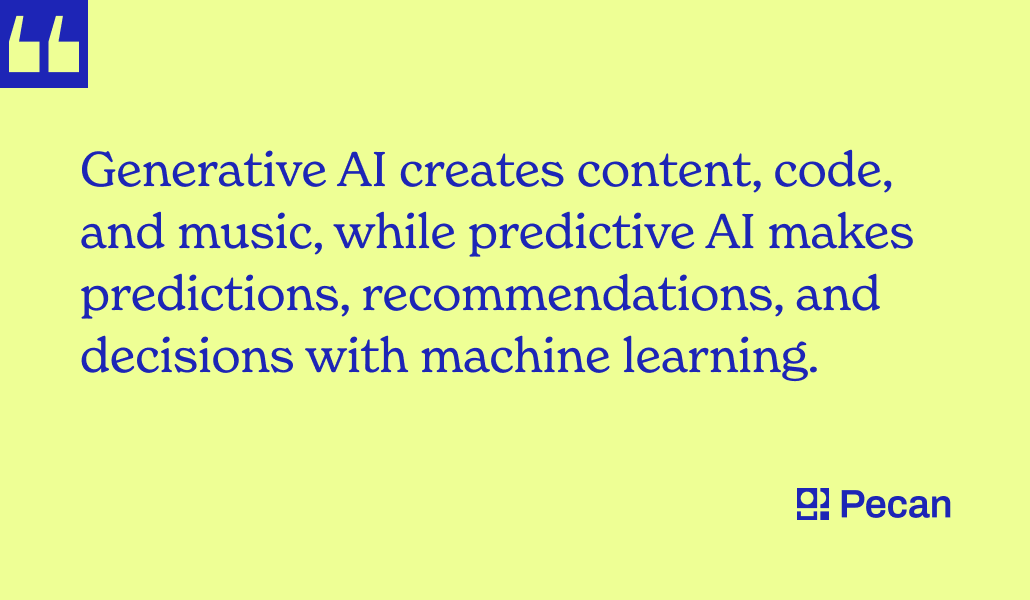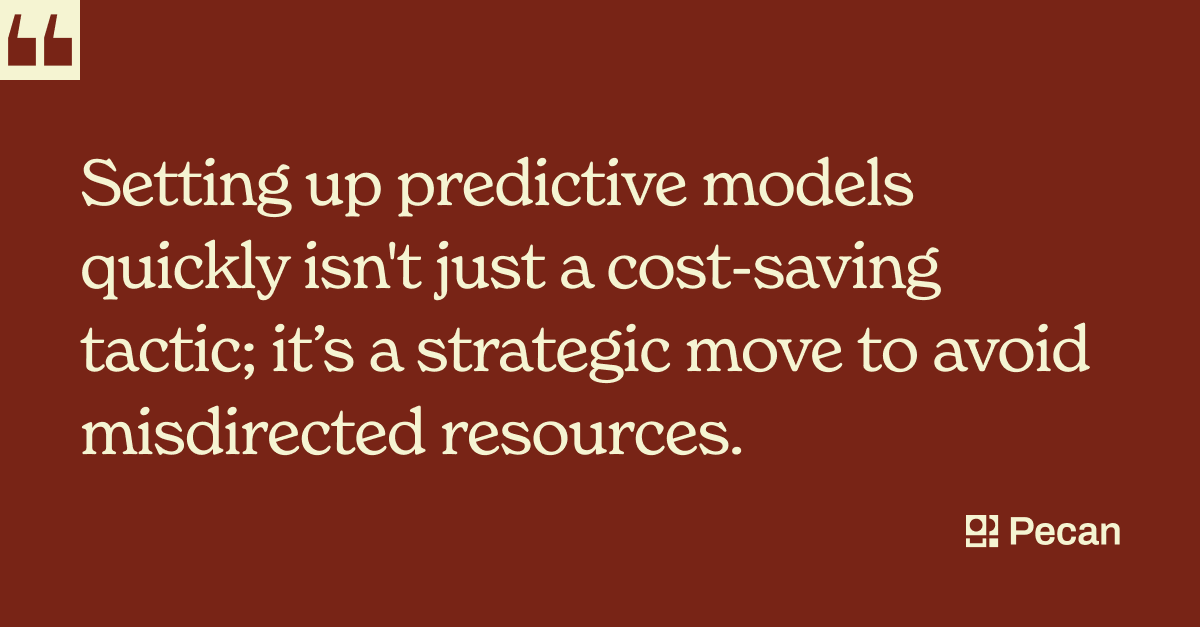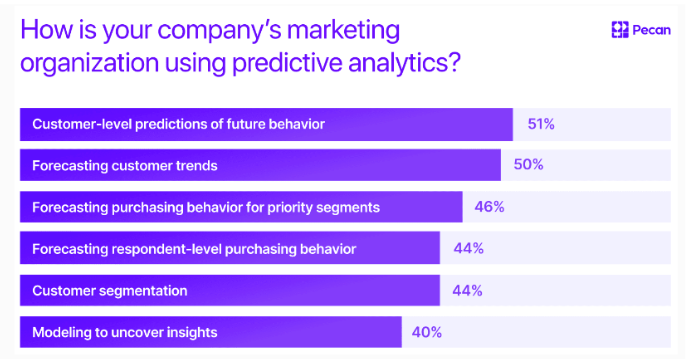In a nutshell:
- Data and analytics leaders face challenges in incorporating AI, balancing security needs and resource constraints.
- AI is now a significant force in the data analytics landscape, moving beyond a trendy buzzword.
- The AI ecosystem includes many tools to enable analytics transformation, but it's important to select one that aligns with company strategy.
- Generative AI and predictive AI each have roles in creating human-like outputs and forecasting future events through machine learning.
- Low-code predictive analytics, like Pecan’s Predictive GenAI-enhanced platform, help data workers build models and find insights securely and explainable.
- Challenges to AI implementation persist, including integration, data quality, and the complexity of AI-powered models.
- Factors to consider when selecting the right AI platform include capabilities, comprehensiveness, integrations, onboarding, cost, security, ease, and customizability.
Let's face it: As a data and analytics leader, your world is a balancing act. Walking the tightrope of security needs and resource constraints while spearheading business initiatives is no small feat. Into this mix sails AI — not just a trendy buzzword echoing through your LinkedIn feed and Slack channels but a significant, transformational force in the data analytics landscape.
In a sea of SaaS tools, you may wonder if boarding the AI ship is necessary — or even safe.
In this guide, we'll break down the AI ecosystem, highlighting the types of tools that can reinvent your approach to analytics and how your team surfaces insights. We’ll also guide you through selecting an AI platform for analytics that aligns with your company’s strategy, including real-life examples.
Don’t worry; this isn't about adding another technology to your already extensive arsenal. Instead, it's about taking a calculated leap into the world of AI and analytics.
With a blend of insight and clarity, we’ll unravel how AI can be a strategic ally in your role as a data leader. Let’s get started.
“State of AI in the Enterprise, 5th edition report,” Deloitte
What’s the difference between generative AI and predictive AI?
As you begin your search for an AI tool for analytics, you'll find two primary types of AI: generative and predictive. Both are integral to modern AI solutions, yet they serve different purposes.
Generative AI’s main role is to take input data and produce outputs that mimic human-like creations, ranging from text and images to complex code. Tools such as ChatGPT, Bard, and Claude are prime examples of generative AI, renowned for their accessibility and versatility. Common uses include automated report generation from data sets or programming tasks like writing JavaScript functions. The core benefit of generative AI is its ability to let users make requests in their natural language and have the AI solution provide or guide the user toward a solution.
Predictive AI, on the other hand, specializes in using large amounts of historical data to forecast future events or trends through the power of machine learning. Common use cases include making predictions for the upcoming quarter, assessing the risk of loan defaults, or forecasting customer churn. The primary advantage of predictive AI is its capability to inform decision-making processes with strategic foresight, an invaluable asset for organizations.
However, you don’t have to choose between these two technologies. Pecan’s Predictive GenAI platform integrates the strengths of both generative and predictive AI, helping your data workers build models and find faster insights in a safe, secure, and explainable way.
These two forms of AI serve unique roles.
What is a low-code predictive analytics platform?
Low-code platforms empower users to quickly pick, build, and deploy models through the help of natural language (generative AI) and deploy these models for precise predictions and insights (predictive AI). This dual functionality not only streamlines the AI experience but also elevates its overall effectiveness, catering to diverse business needs.
By incorporating both generative and predictive AI in a user-friendly, low-code environment, Pecan democratizes access to advanced AI tools, extending their use beyond trained data scientists to a wider professional audience. With Pecan, generative AI works hand in hand with auto-generated SQL, paving the way for smooth integration, interaction, and customization. Whether you're a seasoned coder or have casually explored AI tools like ChatGPT, low-code predictive analytics platforms can help you quickly tap into the power of data science and machine learning at scale.
How do low-code predictive analytics platforms differ from traditional machine-learning solutions?
When it comes to building and deploying machine learning models, the traditional route often feels like a complex maze. It's intricate, resource-heavy, and can seem exclusive to data scientists. This is where low-code predictive analytics platforms step in, offering a fresh, streamlined path.
Key differences include:
- Speed of development: Traditional AI development can be a slow, meticulous process, but low-code platforms change the game. They're about getting things done quickly, moving from concept to deployment rapidly, and keeping pace with the agile nature of your business. With a low-code interface and the power of generative AI, you can accelerate every step of the machine-learning process, including model selection, feature engineering, building, training, fine-tuning, deployment, and monitoring.
- Resource requirements: These platforms significantly reduce the need for a large team of highly specialized data scientists and software engineers. Think of it as a bridge that connects users with deep business knowledge to intricate technical expertise, making the journey into AI-powered analytics more attainable and cost-effective than ever.
- Interoperability: Compatibility is key in your infrastructure. Our AI platform is designed to integrate smoothly with your existing tech stack, removing the friction often encountered in deploying new technologies.
- User accessibility: The beauty of low-code platforms lies in their simplicity. They're built to be user-friendly, opening up AI’s potential to a wider audience within your organization, not just those with coding expertise.
- Customization: Contrary to the one-size-fits-all concern, our Predictive GenAI-enhanced platform focuses on offering customizable solutions. This means you can tailor AI models with SQL to fit diverse business needs and specific tasks without sacrificing depth for accessibility.
Speed of AI implementation is a key consideration due to the opportunity cost during delays.
Addressing Challenges in AI Implementation
No matter which type of AI platform you decide to use, getting started on the AI journey is an intricate and dynamic endeavor, particularly for the data leaders steering the ship. This journey transcends the typical tech upgrade and charts a course through intricate and, sometimes, uncharted territories of technology and strategy. Here are a few things to look out for:
Integration
Merging AI with your existing systems is crucial for synergy. This task demands a nuanced approach to ensure that AI doesn't just coexist but actively enhances your legacy systems.
Data quality
In the realm of AI, the adage "quality over quantity" rings especially true. The effectiveness of any AI solution hinges on the quality of data at its disposal. High-quality, relevant data is the foundation upon which AI algorithms can build reliable and insightful outputs.
“As companies rapidly embrace AI and realize its benefits, trust must be their top priority. And to instill trust in AI, they must first instill trust in the data that powers it. … Simply put, organizations can only harness the full power of AI when it is fueled by accurate, comprehensive data.”
— Wendy Batchelder SVP, Chief Data Officer, Salesforce
Complexity
AI-powered models are sophisticated and require a deep understanding to be fine-tuned effectively. It's a task that goes beyond surface-level adjustments, exploring the intricate workings of each model to ensure they align perfectly with your business objectives.
Preparing your team for the AI transition is about cultivating a new mindset. It involves fostering an environment where your team understands AI and is equipped to adapt to its ever-evolving nature. This step is about embracing a cultural shift, making AI an integral part of how your organization thinks and operates.
How Low-Code Predictive Analytics Can Help You Accomplish Your Goals
You or your tech team might be championing the AI cause — and for good reason. From richer analytics to quicker conclusions, there are lots of reasons analytics leaders are excited to get their hands on AI tools. We’ve found that companies are using predictive analytics to do everything from predicting future customer-level behavior to customer segmentation, all with the goal of improving their workflows.
Source: Pecan's State of Predictive Analytics report
But as a chief data officer, the business's success is your top priority. Each tool you integrate into your company needs to play a role in bolstering your bottom line, or it’s just not worth the investment. Thankfully, low-code predictive analytics has some serious advantages:
Speed and efficiency
According to Microsoft’s 2023 Work Trend Index Report, 64% of employees don’t have enough time and energy to get their work done — and those employees are 3.5x more likely to say they struggle with being innovative or thinking strategically. The time-consuming tasks that eat up your data analysts’ and data scientists’ time — coding, data wrangling and cleansing, model selection, and more — can be partially or fully automated, helping your team focus on strategic, human-centric activities.
Clearer business decisions
Low-code predictive analytics empowers data leaders by turning complex data into actionable insights, facilitating clearer and more strategic business decisions. But how does it achieve this?
- Data-driven predictions: At its core, low-code predictive analytics analyzes historical data and identifies patterns. By examining past trends and outcomes, it forecasts future scenarios. Think of it as a sophisticated detective piecing together clues from your business’s history to predict what's likely to happen next.
- Accessible analytics: Traditional data analysis often requires deep technical expertise. Low-code platforms, however, democratize this process. They provide intuitive interfaces where you can manipulate and explore data without needing advanced coding skills. It's like having a high-powered analytics engine with a user-friendly control panel.
- Automated insight generation: In today’s fast-paced business environment, being agile is key. Low-code predictive analytics tools process data automatically, allowing you to make decisions on the most recent data. You can quickly adapt to market changes or customer behavior. This immediate insight can be the difference between capitalizing on an opportunity and missing the boat.
- Scenario simulation: One of the standout features of low-code predictive analytics is its ability to simulate various scenarios. Want to know the impact of a pricing change or a new marketing strategy? These platforms can model different outcomes, helping you to weigh options and choose the most promising path.
- Targeted decision support: Whether it’s identifying which customer segments are most likely to grow or where to allocate resources for maximum ROI, low-code predictive analytics provides targeted recommendations.
Achieve richer data, faster
Your team wants to use the data available to them. In fact, 62% of marketers we surveyed believe putting their data to use in decision-making would be the most valuable way to use predictive analytics for KPIs.
But creating a machine-learning model from scratch takes an exceptional amount of time and resources. Your data team will thank you if you skip the hustle and opt for a low-code AI option, achieving the benefits of a custom-built model without wasted energy.
Ease the strain of talent shortages
Here’s the thing: tech businesses run tight ships. When you’re leading with a budget in mind, you don’t have loads of programmers sitting around. Building and testing models in the traditional way takes a substantial time investment, and that time could be better spent working with a preexisting tool.
And fear not: you won’t be replacing your whole data science team with a robot. Instead, you’ll be making better use of their strengths by helping them rapidly iterate on models and solving business problems rather than fine-tuning and testing their code.
Bolster your business teams
You don’t want a tool that only programmers can use. The ease of use of low-code platforms allows less technical stakeholders like business analysts to reap the benefits of the technology. While no tool comes without a learning curve, your team members can wrap their heads around a low-code platform without learning a new language. Plus, low-code tools make collaboration between data scientists and analysts possible.
Resolve security concerns
There’s no doubt that security is at the top of your mind as a data leader. Data regulations and security are an ever-moving target and achieving data security can be a complex task. However, when company teams design their own AI models and tools, they are wholly responsible for creating a secure program. When you engage a tried-and-tested low-code platform, you can count on built-in security measures and credentials.
Incentivize staff with new skills
Keeping morale high is an important job of a data leader, and there’s no doubt it positively affects your business’s performance. Engage your data team with the learning opportunities that a cutting-edge tool offers. Allowing your staff to upskill is a great way to increase employee retention rates and empower creative thinking.
How to Select the Right AI Platform for Your Business
Now that you’re sold on the importance of a low-code AI platform, you’re met with the next hurdle: picking the right tool for your company. There are a lot of tools on the market, and selecting the right one can feel like a shot in the dark. Before you make an investment in a tool, consider the following variables. We’ll briefly cover each in the following section.
- Capabilities
- Comprehensiveness
- Integrations
- Onboarding
- Cost
- Security
- Ease
- Customizability
Capabilities
Not all low-code AI platforms are created equal. In fact, they vary significantly in their capabilities. For one, many low-code tools are exclusively built to produce generative AI. If you’re looking to take advantage of human-like outputs or if you’re looking to speed up your coding processes, a generative AI tool may be just fine.
However, a low-code predictive analytics platform provides deeper, richer benefits for your company, the best of both worlds: a generative AI tool that develops your own custom predictive AI model and the predictive AI model that provides the insights you need.
Comprehensiveness
Many low-code AI tools have a narrow scope of outputs. When that’s the case, you can count on having to string together tools to get the full picture of your company’s data. If you have a small need for your AI tool, a specific tool can check the box. However, if you’re hoping to invest in a tool that can accomplish various tasks, you’ll want to find a more comprehensive solution.
Customization
Traditional AI model-building methods can be far more customizable than low-code platforms, but that’s not always the case. Some low-code platforms exhibit extraordinary levels of customizability. Think about your company’s needs for the AI tool. Do you want to ask specific, niche, predictive questions? Or are you planning to stick to more generic, less industry- and niche-specific inquiries? Clarify your needs before investing in a tool to avoid over- or under-investing.
Deployment
Onboarding is an often overlooked but vitally important part of implementing any SaaS tool into your company workflow. Chances are that you and your team have suffered technical bottlenecks from difficult-to-contact SaaS teams. When poor onboarding happens, integration suffers, and the end result is underutilization.
TL;DR: Bad onboarding = wasted resources.
The support you receive during the sales process can be a powerful indicator of future dependability. Make sure that the company you invest in has a procedure for onboarding that’s communicative, reliable, and proven.
Cost
Cost is a vital component of an investment calculation. When you’re considering adding a tool to your SaaS mix, you want to consider the overall investment and the payment type. Some tools are paid upfront, while others are paid monthly. Depending on your company’s cash flow, one type of method may be a better fit.
You also want to consider the tool’s capabilities when calculating the cost. If you’re purchasing a tool with a narrow scope, you’ll likely need multiple tools to satisfy your AI goals over time. A tool with a higher production level or with more comprehensive capabilities will likely have a greater impact on your bottom line and, therefore, be worth a larger investment.
You should also factor training time into your TCO (total cost of ownership). There are additional costs and time delays associated with training.
Security
One of the key advantages of using a low-code platform instead of a tool constructed in-house is the built-in security measures. However, each tool will have varying security and compliance measures, so you’ll want to ensure it’s checking the necessary measures for your company. This may also relate to the tool’s integrations — if your data storage tool is compliant but doesn’t integrate well, you’ll want to find a tool that’s a stronger fit.
Interface usability
While all low-code tools will be more approachable than the traditional alternative, they will have a significant variance from one to another when it comes to interface usability. Consider your usability goals when deciding what platform is the right fit. If you’re looking for a product that non-technical stakeholders can take advantage of, interface usability should be a priority. However, if you aim to keep the tool in the data scientist’s world, a more technical interface is a non-issue.
Pecan’s Predictive GenAI Platform
Our Predictive GenAI-enhanced platform lets you use natural language prompts to tap into the power of predictive AI. Our platform leads you through the construction of a pointed predictive AI inquiry and then utilizes auto-generated SQL to help you define the right training dataset. Then, with a click of a button (and our automated processes working behind the scenes), you can bring your model to life.
We make it simple for you to move through the tool checklist for our low-code platform. Here’s a quick breakdown of Pecan’s attributes across your buyer’s checklist:
- Capability: Predictive GenAI uses generative AI to inform and accelerate the construction of predictive AI models. While the platform is primarily designed to produce predictions, it helps kickstart the modeling process by guiding the user and auto-generating critical SQL code. Predictive GenAI’s capabilities are far-reaching.
- Comprehensiveness: Predictive GenAI is different from many low-code AI tools on the market because of its comprehensive nature. You can use our solution to accomplish various tasks and create many different types of predictive AI models.
- Customizability: Predictive GenAI is highly customizable. Because of the way we use generative AI and automation to define and construct models, you can create predictions based on a nearly unlimited scope of variables. Regardless of how niche your request is, our tool is designed to construct a useful and powerful predictive model, using auto-generated SQL to define training sets and our automated tools to build predictive models.
- Integration: Pecan integrates well with a variety of databases and CRMs, including Salesforce, Snowflake, Oracle, and Google BigQuery. We’re also compatible with several attribution platforms, and CSV files can be plugged directly into our AI tool.
- Onboarding: Our onboarding process begins with a demo, and from there, you can expect support throughout the entire buying process. Once you’re a customer, we have in-app support ready to answer your questions and concerns, making sure that integration goes off without a hitch.
- Cost: We offer different price tiers for monthly subscriptions based on the size of your company and the breadth of your AI initiative.
- Security: Security is one of our top priorities. We engage in passive and active security measures that ensure your data is kept safe within our AI tools. Not to mention, our certifications include ISO 27001 and SOC2 Type II. Here’s more information about how we keep your data safe.
- Interface ease: No specialized training is necessary to take advantage of our Predictive GenAI platform. If you can work with a chatbot, you can learn to navigate the generative and predictive capabilities of our solution.
Success Stories
From start-ups to Fortune 500 companies, Pecan’s Predictive GenAI platform has upped the game for customers across industries. Our customers have used Predictive GenAI to reduce costs, increase outreach, double upsells, and more.
Transforming roadside assistance with CAA Club Group
As Canada's largest not-for-profit automobile association, CAA Club Group (CCG) is dedicated to providing exceptional safety for its over 2.5 million members. The team at CCG faced significant challenges in developing timely and accurate safety forecasts, which are crucial for the strategic deployment of roadside assistance.
Recognizing the need for a more efficient method, CCG turned to Pecan’s platform. The integration of our tool into their workflow revolutionized their forecasting process, leading to a remarkable 30% reduction in time spent on generating these vital forecasts. This enhancement in efficiency has been pivotal in improving the logistics and readiness of their roadside assistance services.
Revolutionizing retail with a global fast fashion brand
A major player in the fast fashion industry with nearly 5,000 stores worldwide faced persistent challenges with overstock and stockouts, significantly affecting their sales and customer experience. Traditional forecasting methods fell short in aligning inventory with the rapidly changing consumer demand patterns.
By adopting Pecan's predictive models, the retailer successfully aligned their inventory with actual customer demand. The result was a substantial 50% reduction in overstock and an impressive increase in sales ranging from 10-25%, thanks to fewer stockouts. Pecan’s predictive models, with an 80-95% accuracy rate, marked a significant shift in their inventory management strategy, leading to enhanced operational efficiency and profitability.
Optimizing high-tech manufacturing
In the high-tech manufacturing sector, a leading supplier to some of the world’s largest manufacturers faced issues with inventory planning due to non-scientific forecasting methods. These challenges resulted in either understocking or overstocking essential subcomponents, affecting their manufacturing lead times and operational costs.
Utilizing Pecan’s platform, the company developed a highly accurate demand forecast model in just 14 days, significantly improving their operations. They experienced a 15% reduction in labor costs, a 25% decrease in inventory costs, and a 20% reduction in machine change-over time. These improvements underscore the impact of Pecan’s predictive AI in streamlining manufacturing processes and enhancing supply chain efficiency.
Pecan's Marketing Mix Modeling led to the identification of over $100 million in overspending. Additionally, the model suggested potential savings of over $200 million through strategic reallocation.
Elevating marketing strategies for a major U.S. company
A leading U.S. company managing a marketing budget of over $1B faced the challenge of optimizing its extensive omnichannel marketing budget. With Pecan’s Marketing Mix Modeling, the company gained valuable insights into its spending efficiency across various channels.
This analysis led to the identification of over $100 million in overspending, primarily in national channels like linear broadcasting and radio. Additionally, the model suggested potential savings of over $200 million through strategic reallocation to more efficient state channels. This optimization enhanced marketing efficiency and significantly improved operational margins.
Security and Compliance in AI Solutions
In today's era, where data is a critical asset, ensuring the security and compliance of AI platforms is a necessity. Recognizing this, Pecan has placed a strong emphasis on implementing robust security protocols and compliance measures in our platform. We understand that the effectiveness of data utilization goes hand in hand with its protection.
Our platform is designed to rigorously protect your data, adhering to the highest data security standards and privacy laws. This commitment extends beyond just safeguarding against external threats — it encompasses a comprehensive approach to maintaining data integrity and confidentiality. Whether it’s adhering to GDPR, HIPAA, or other regional and industry-specific regulations, our platform is equipped to handle the complex landscape of data compliance and security.
By integrating stringent security measures, we ensure that you can leverage AI's power without compromising the safety and privacy of your data. This dedication to security and compliance is the cornerstone of our platform, providing you with the confidence that your data can safely be used to its fullest potential.
Our platform is designed to rigorously protect your data, adhering to the highest data security standards and privacy laws.
Start Using AI for Predictive Analytics Today
While no single tool is the magic bullet for all data challenges, Pecan's low-code Predictive GenAI platform comes pretty close. With an accessible interface and seemingly endless predictive analytics use cases, you can feel empowered to make data-driven decisions at scale.
While choosing the right tool for you can be intimidating, understanding the variables that make up an AI platform is a critical first step. As you proceed through the decision-making process, refer to the variable checklist and take the time to select the right tool for your team.
If Pecan seems like a good fit for your business, we’d love to chat further. Please feel free to reach out and schedule a demo with our team, and we’ll walk you through the tool and answer all your questions so you can feel confident in your AI investment.










